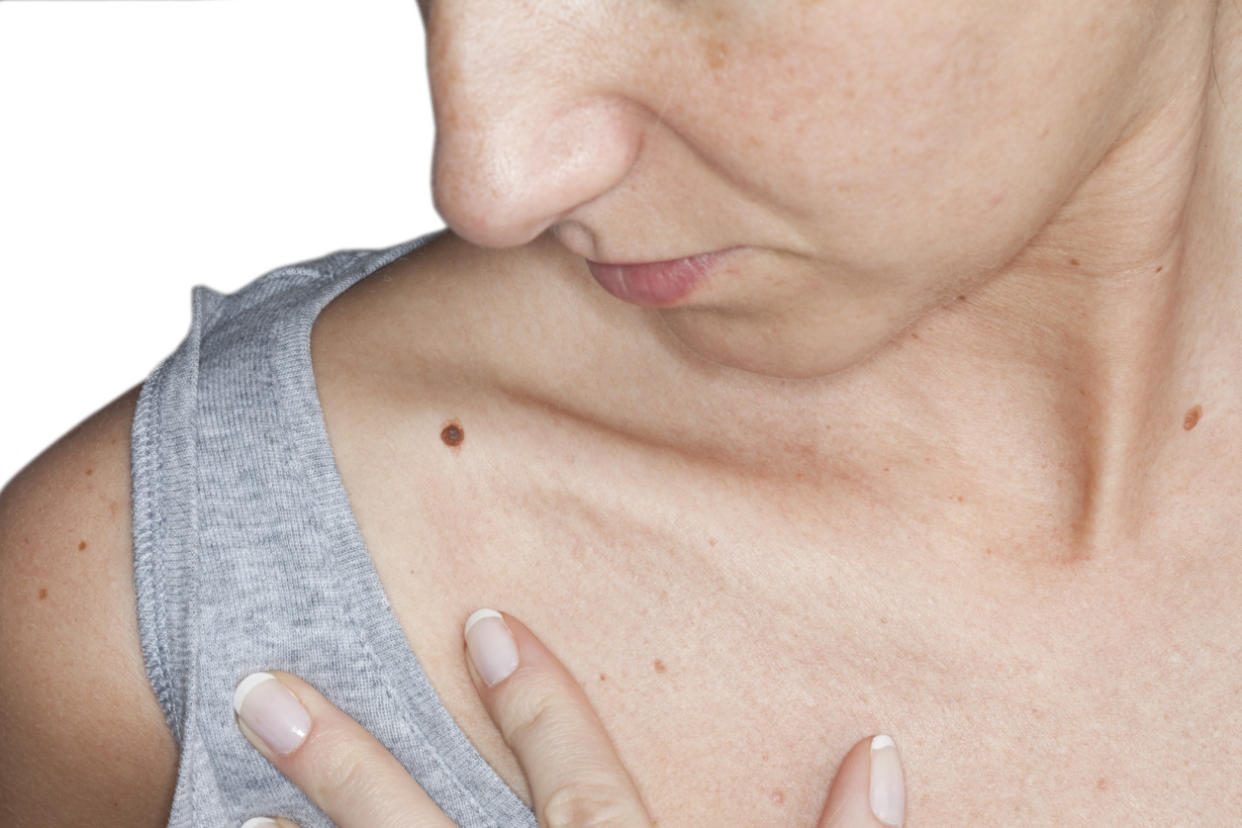Stop What You're Doing and Count the Number of Moles on Your Arm Right Now

Researchers say that the number of moles on your arm is a good predictor of your skin cancer risk — and examining a specific portion of your arm will give you the most accurate info. (Photo: Getty Images)
Scientists have discovered a new way to determine your risk of developing skin cancer: Look at your arm.
Researchers from King’s College London found that having more than 11 moles on your arm is an indicator of an increased risk of developing skin cancer.
For the study, researchers used data from nearly 3,600 twins that was collected between January 1995 and December 2003. The twins had a skin exam that recorded their skin type, hair and eye color, and freckles, as well as mole counts on 17 different areas of the body.
The British scientists discovered that the right arm was the best at predicting the total number of moles a person had on his or her body. Those who had 11 on the right arm were more likely to have more than 100 moles total — a skin cancer risk predictor. Now, this study was done in the UK, where people drive on the other side of the road, thus their right arm is the one that incurs that most sun damage. In the US, however, it would be your left arm that sees more sun — so Americans should count moles on their left arms. (Most adults have between 10 and 40 moles on their body, according to the American Academy of Dermatology.)
One in five Americans will develop skin cancer during his or her lifetime, according to the Skin Cancer Foundation, and an estimated 73,780 new cases of invasive melanoma, the most deadly form of skin cancer, will be diagnosed in 2015.
The new study was designed to find a way to make it easier for people to count the moles on their body and assess their skin cancer risk — and experts say it succeeded.
Related: The Scary Causes Behind the Rise in Skin Cancer Rates
“Counting all of your moles can be difficult and time-consuming. This is an easy way to tell if you’re at risk,” Marie Leger, MD, PhD, an assistant professor of dermatology at NYU, tells Yahoo Health.
While genetics plays a role in the development of skin cancer, Jill S. Waibel, MD, founder of the Miami Dermatology and Laser Institute, tells Yahoo Health that lifestyle is the biggest factor when it comes to developing melanoma — and moles can be an indicator of that.
“Moles on the right arm can be tied to a person’s melanoma risk because this indicates that the body has been exposed to the sun,” she explains.
Researchers discovered that the upper arm (above the elbow) in particular was a good predictor of a person’s skin cancer risk, which doesn’t surprise Waibel.
“If the moles are located on the upper arm, this indicates that the arms themselves have been exposed to the sun and potentially without regard to wearing protective clothing, sunscreen, or taking other precautionary measures,” she says. “The fact that the arms themselves have an excess number of moles suggests extreme amounts of sunlight and abuse to the skin.”
How do you know if it’s a mole or a freckle?

Freckles are pictured, left. The two darker spots in the photo on the right are moles. (Photo: Getty Images / Mayo Clinic)
Moles often appear as small, dark brown spots and are caused by clusters of pigmented cells. According to the Mayo Clinic, they’re usually less than ¼ inch in diameter, can be smooth, wrinkled, flat or raised and can vary in shape from round to oval.
Freckles are flat, usually paler brown, and may fade after sun exposure. They do not contain any cells that contain the skin-pigment-producing substance, melanin, while moles do.
Related: 3 Tips to Apply Sunscreen the Right Way
People with light skin who burn easily, those with red or blond hair, men over the age of 50, and those with a family history of melanoma are particularly at risk of developing skin cancer, says Leger, but anyone can develop the disease.
To lower your risk of skin cancer, she recommends wearing sunscreen daily (even in the winter), limiting your sun exposure, and wearing protective clothing when you’ll be out in the sun.
Early detection is key, which is why Leger, Waibel, and other dermatologists recommend getting your moles checked by a board-certified dermatologist each year, even if you aren’t at a higher risk for developing skin cancer. (Leger points out that people with darker skin are often diagnosed with melanoma in the later stages, which can make it more difficult to treat.)
Counted your moles and realize you have 11 or more? Make an appointment with your dermatologist to get them checked out ASAP.
Read This Next: One Woman’s Story Highlights the Hidden Skin Cancer Risks for People of Color
Let’s keep in touch! Follow Yahoo Health on Facebook, Twitter, Instagram, and Pinterest. Have a personal health story to share? We want to hear it. Tell us at YHTrueStories@yahoo.com.

